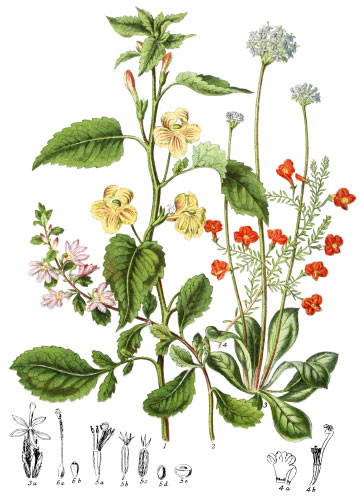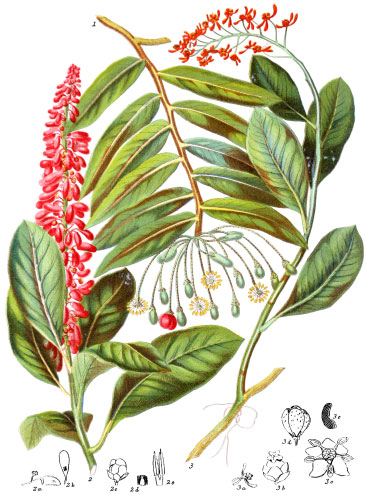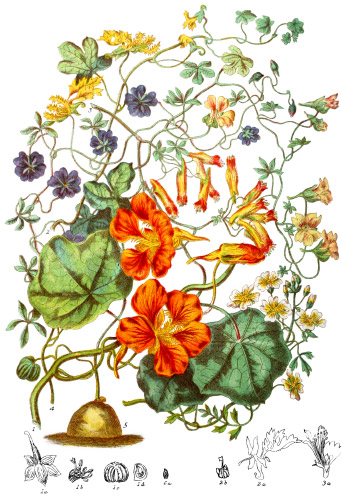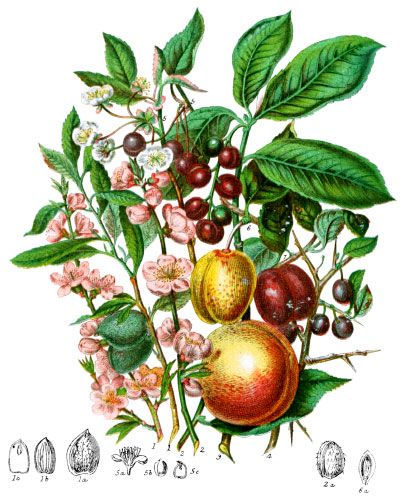Key characteristics
Undershrubs and herbaceous plants. The leaves are alternate, or in clusters, undivided, somewhat sheathing at the base, sometimes marked with transparent dots. The flowers are either in loose panicles or combined into close clusters. The calyx is tubular, plaited, persistent, sometimes coloured. The corolla is of one petal, with a slender tube of five petals with a long narrow claw. The stamens are of definite number, in Plumbago fixed to the base of the ovary; in Statice and its immediate allies, placed on the petals. The ovary is one-celled, one-seeded; the styles usually five, with the same number of stigmas. The fruit is a nearly-closed utricle. The seeds contain a small quantity of mealy albumen.
This Tribe has some affinity with Plantaginaceæ, but is distinguished by the plaited calyx.
Tonic and astringent, acrid and caustic properties exist in these plants.
Select plants in this order
Not all plants listed are illustrated and not all plants illustrated are listed.
- Plumbago derives its name from a substance found in the root of the European species, in colour resembling black lead; it is used as a remedy for toothache in France, but stains the teeth grey, this peculiar caustic colouring matter is called Plumbagine.
- P. europæa is the only species belonging to Europe, but several exotic species are cultivated in our conservatories for ornament, though not for use.
- P. capensis (1) is a graceful plant, and produces its delicate flowers throughout the summer.
- P. rosea (2) was brought from the East Indies by the celebrated Dutch traveller and botanist Rumphius, in the last century; he called it blister-root, from the use made of it by the natives.
- P. scandens climbs over hedges in St. Domingo and Rio Janeiro; it has a white flower, and is considered to possess medicinal properties in South America.
- P. zeylanica is found in Ceylon and in Australia.
- Statice is a genus known to, and described by Pliny; it is dispersed throughout Europe and from Siberia to the Mediterranean, is found also in Egypt, in the Canaries, and at the Cape of Good Hope.
- S. purpurata (3) having been introduced from South Africa in 1800, has been occasionally seen in our gardens from that time.
- S. speciosa and others are natives of Russia, all of a durable nature and pleasing aspect.
- S. imbricata, a shrub of Teneriffe, is a beautiful species, with small purple flowers.
- S. Caroliniana is a very powerful astringent, used medicinally in America.
- Several are woody shrubs; in Cabul a large portion of fuel wood is obtained from Statice.
- S. Limonium is the Sea Lavender, frequent on the muddy shores of the mouths of our smaller rivers.
- The flowers of this genus and Armeria have five separate petals, the stamens attached to their base.
- Armeria vulgaris (4) grows plentifully on most parts of the English coast, particularly abundant on the shores of the Isle of Wight and other southern positions, extending along the cliffs to the Land’s End westward. It forms a good bordering for gardens, and is preferred for that purpose in some situations where the soil is favourable.
- Armeria differs chiefly from Satice in the flowers being collected in close round heads, having an involucre at the base, forming a kind of sheath at the top of the stalk.
- Ceratostigma is a native of China.
- Vogelia belongs to the cape; it records the name of a zealous but unfortunate explorer of African plants, who fell victim to the climate.
- Ægialitis grows amongst the mangroves of Northern Australia, and in the Delta of the Ganges.
Locations
This small Tribe is found thinly scattered from Greenland to Cape Horn, inhabiting salt marshes and sea-coasts, in Temperate regions; abundant on the shores of the Mediterranean, and in the southern provinces of the Russian empire; rare in the Tropics and China. Plumbago belongs to Europe, India, America, the Cape of Good Hope, and Australia.
Legend
- Plumbago capensis, Blue Plumbago. Cape of Good Hope.
- Stamens and Pistil.
- Ovary.
- Plumbago rosea, Red Plumbago. East Indies.
- Statice purpurata, Purple Statice. South Africa.
- Armeria vulgaris, Common Thrift. England.
- Calyx.
- Section of Flower.
- Ovary and Pistil.
Explore more
Posters
Decorate your walls with colorful detailed posters based on Elizabeth Twining’s beautiful two-volume set from 1868.
Puzzles
Challenge yourself or someone else to assemble a puzzle of all 160 botanical illustrations.





